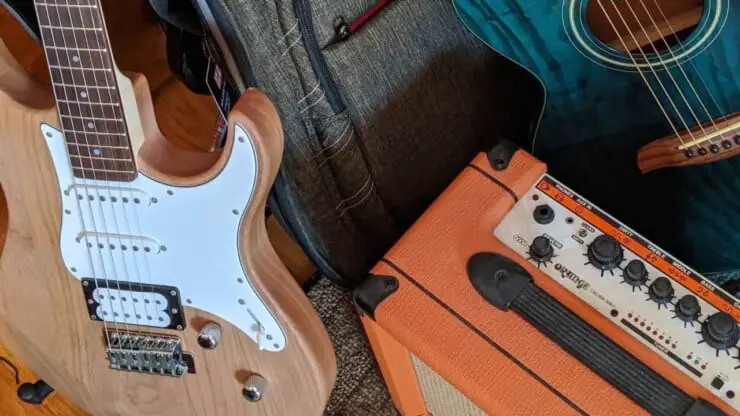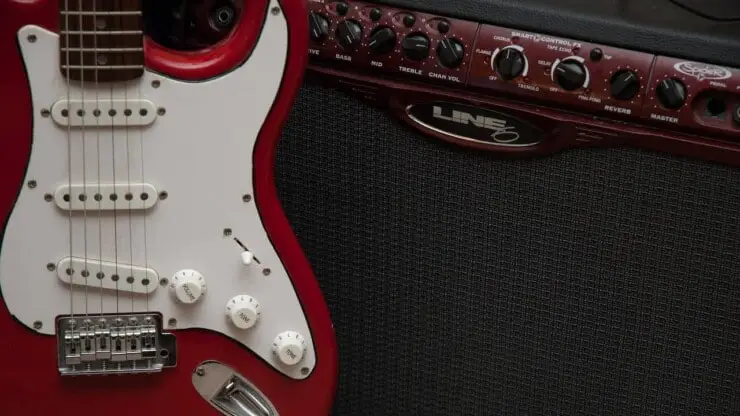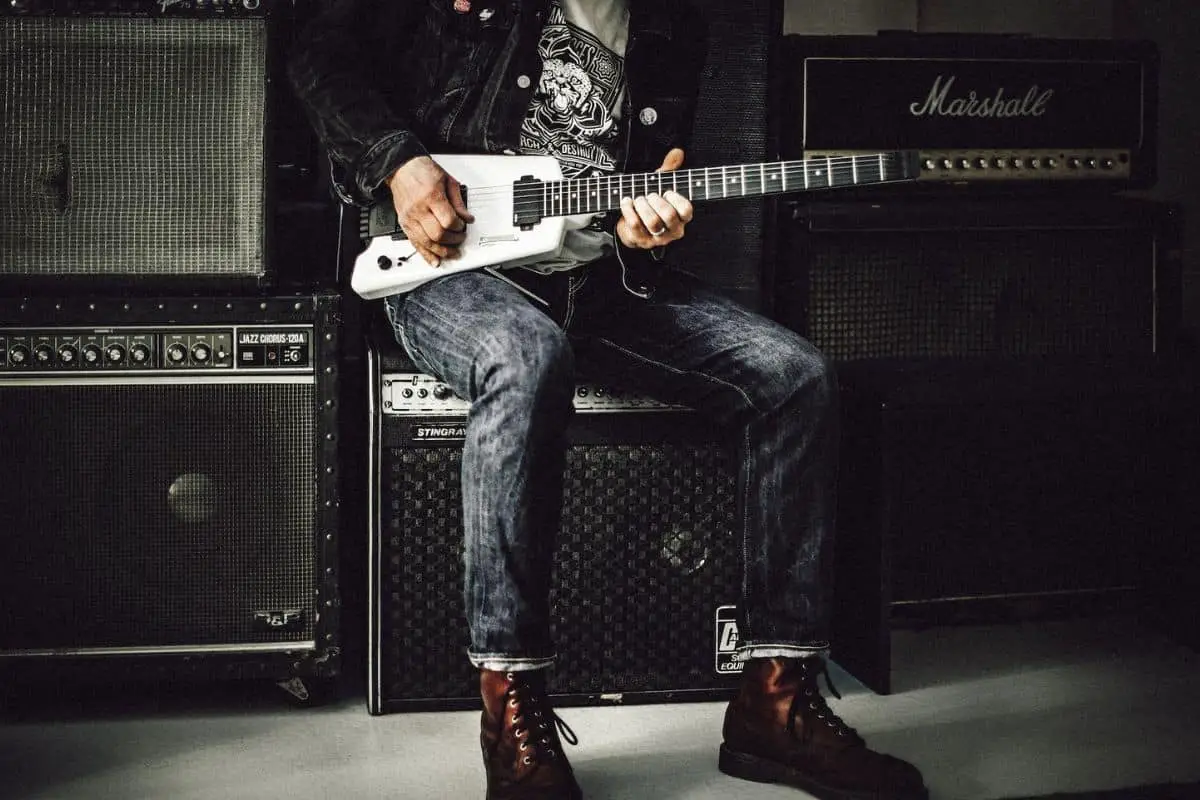Have people been recommending you to use a combo amp in your rig, but you don’t know what is a guitar combo amp? If so, then don’t worry because by the time you’re done reading this article, you’ll know all about guitar combo amps.
A guitar combo amp is an audio electronic device in which the signals travel from the guitar’s pickup to the amplifier, and they get amplified or enhanced, which results in a louder sound. It is more or less a necessity in a guitarist’s guitar rig.
In this article, you’ll get to know all about what is a guitar amp, how to choose your first guitar amp, what is a guitar combo amp, what does a guitar amp head do, and a lot more. Continue reading to get all the answers you’re looking for.
What is a guitar amp?
When talking about electric guitars, it’s almost impossible to imagine one without a guitar amp. Guitar amps have become an integral part of any guitarist’s life. It’s hard to imagine one who plays the guitar without an amp. What is an amp? It is an electronic device used for strengthening coming out of the guitar. If you’ve tried to play an electric guitar without an amp, you’ll immediately realize that it’ll be impossible for the audience to hear what you’re playing.
So, what does an amp do for electric guitar that makes it audible for the listeners? The guitar amp comes with a power amplifier inside the box or a preamp. Normally, the amplifier comes with a speaker as well, so you won’t require a separate box to be able to play the guitar. The signal will then travel from the guitar’s pickup to the amplifier. It’ll then get amplified or enhanced and sent to the speaker so that the audience can hear it. There are many ways to amplify your guitar’s sound, and the most common ways are through vacuum tubes or transistors.
What is a guitar combo amp?
A guitar combo amp essentially comes with the amplifier and speaker, similar to a head and cabinet setup. Everything will be in one piece of equipment instead of multiple pieces. These are some perks of playing with a guitar combo amp –
- It will be compact – Even though the head and cabinet might be lighter to carry, it’ll be more inconvenient. With a guitar combo amp, everything will be compact. It’ll be in a single piece of equipment and will not require more than a single trip to haul.
- Cost of the amp– As you’re purchasing a single piece of equipment instead of two, combo amps are often less expensive than the amp head and cab setup.
- Venue size of the venue – If you’re playing mostly small local gigs, a guitar combo amp would be sufficient. You could get far more out of this type of amp than you think.
- Open vs. closed back – With a guitar combo amp, you’ll get the choice between a closed and open back. An open back will allow the sound to come out from both sides of the speaker. Meanwhile, the closed back will only put the sound out through the front. Most comp amps will be made with an open back.
Guitar combo amp tone and effects
The kind of music that you’re looking to play will affect the type of guitar amp you should buy. A basic understanding of amp tones and effects will go a great way in helping you make your final decision.
EQ Controls and Settings
All amps will have some type of “equalization” or EQ built in. These controls are often labeled bass, treble, and mid. These controls will help you achieve the desired tone. EQ is a significant part of any guitar combo amp. These controls will help you with sounding good in almost every environment. Moreover, you’ll be able to shape the amp’s frequencies to sound best in the room you’re playing in.
Distortion in the amp
Most guitar amps will come with a gain knob. This will control the amount of distortion in your sound. For instance, punk and heavy metal bands normally come with a thick distorted tone.
Reverb in the amp
Reverb is the standard effect that sounds like the echo effect in a big empty room. Although not every guitar amp comes with reverb, it can be found on most small practice amps.
Different digital effects
Effects can be quite a useful feature in a lot of different guitar amps. However, it’ll be best for beginners to not get carried away. Eventually, guitarists will feel a need for them as they upgrade their skills. Some guitar combo amps come with a wide array of digital onboard effects that you’ll be able to choose form. Many experts and professionals prefer using pedal boards that they can easily customize with different effect pedals.
By having different digital effects built into the amp, it’ll allow you to experiment with different effects without needing to buy pedals separately. When you’re looking for upgrading to a bigger amp to play live, you can always pick and choose which effect pedals you want to work with.
Switch between multiple channels
Another great feature that some guitar combo amps have is the option to switch between different channels. You’ll get two or three channels featuring different types of sounds to choose from.
This is commonly achieved through the use of a foot switch. It will give you the option of toggling back and forth between different channels. Some single-channel guitar amps feature a foot switch that turns the effects on and off.
Key factors to remember when choosing your first guitar amp
There are many factors that you should consider when purchasing your first guitar amp. You’ll want to ensure that you’re making a good first investment, as the amp will be a part of your rig for a long time. Here are some of the features to look for if you want to buy the best guitar amp for a beginner.

Portability and guitar amp size
When it comes to choosing your first guitar amp, going for the best size would be a great place to start. When you’re sizing, guitar amp range from tiny micro amps all the way to the giant rigs with multiple speaker cabinets.
For a beginner, a small practice amp will be a good place to start. Because of its small size, a small guitar amp will be great for musicians who have to travel. It could be either for practice sessions, on the road, or for their next gig.
Speakers and guitar amp wattage
When selecting your first guitar amp, two key factors that you must consider are the configuration of the speakers and the wattage of the amp.
There are many misconceptions surrounding the necessary wattage needed for the guitar amp. Most “pro” amps normally come at 30-100 watts. The loudness doesn’t actually double when you’re doubling the number of watts. A 30W amp is just 5 decibels quieter than a 100W amp.
Most amps sound best once they’re turned up about halfway. If your guitar amp doesn’t get turned up past 3, then you should prefer using a smaller amp. You’ll want to ensure that the speakers are rated for the amount of power that the amp will produce.
When selecting the speaker configuration, you should consider the wattage of the amp and impedance. Some of the more popular speaker configurations include one 12-inch speaker, two 12-inch speakers, and four 12-inch speakers. When performing or for gigs, you’ll be fine with using one 12-inch or two 12-inch speakers. Keep in mind that in most cases, the amp will be connected to the PA system.
As for home use, you don’t need an amp that uses more than 20W of power. Having a high-powered amp at home will be like having a race car that isn’t allowed to drive over 20mph. You don’t require a lot of wattage to sound great. Likewise, most practice amps will come with a single speaker between 8-inches and 12-inches in diameter. The practice amp will be for practicing at home in an intimate setting at a reasonable volume. You can save the big guitar amp for onstage performances.
Realtime performance feedback
You don’t always have to practice playing the guitar on your own. With a decent combo amp, you’ll get live performance feedback to accompany you. It’ll help you practice smarter and not harder.
If you’re looking to use the amp in a recording situation, having a smaller amp is usually better. For instance, the legendary Jimmy Page made use of a small 15W Supro combo amp in the studio. It helped him create the huge guitar sounds on the initial Led Zeppelin hits. Some guitarists prefer using multiple amps in the studio while blending their sound to get the perfect one.
The same will hold true for playing live. Gigantic amps aren’t really needed, as most venues make use of mics on the amps for better controlling the sound that the audience hears. Moreover, you’ll have onstage monitors that’ll offer sound to you and your bandmates. The only real consideration will be the prospect of competing with the natural volume of the drum set.
When you’re seeing bands play arenas, they normally use dummy cabs onstage for looks. Most of them don’t even contain speakers. The most power that you’ll generally need for playing live in most situations is 30-50W. A cab having one or two 12-inch speakers will be more than enough for live shows. For big venues, a 4×12 cab is often used, especially for heavy bands. You can save the full stack 100W amp and multiple cabs for when you’re hitting the big time.
What type of amps should you choose?
There are many discussions whether tube amps are better than transistor. Ultimately, it’ll all boil down to what you prefer as a guitarist and your budget. Both of them will have their advantages and disadvantages. It’ll be false and misleading to state that one is better than the other.
Interestingly, both solid-state and tube amps come as an amp only. There is no speaker, and you wouldn’t be able to play the guitar using them if you don’t have a speaker for them. Most of the cheap amps come as solid-state and as a, what guitarists call combo. The combo will be a term used for describing an amp that comes with a speaker in the same box. The box for the amp is made of wood, with the tone controls being located on the top. Meanwhile, the bottom part will be the speaker only.
However, it’s possible to find an amp without the speaker. This combination is normally used on high-end equipment. Here you’ll need to get a stack or multiple stacks where they are one or four speakers in the box. The other thing worth mentioning to shape the sound of the guitar will be effects and pedals. The amps have reverb, drive, and more, but it isn’t possible to get these effects in a pedal. By using a pedal, you’ll be plugging the guitar into a pedal and connect the pedal to the amp. This way, you’ll already have a modified tone to the preamp.
Of course, the better amps come with an effect loop. Here, the sound comes directly from the guitar to the preamp section. After that, the pedals alter the sound already amplified and send it to the power section. The guitar amps having effect loops are popular and the reason for it is that they act as if all the pedals are located in the amp from the start.
What are guitar amp heads?
When talking about an amp, the first thing that pops into most people’s heads is the standard guitar combo amp. These combo amps come with all the essential components combined into one device. You’ll have a preamp, a power amp, and a speaker cabinet together. All you’ll need to do is plug in, turn the amp on, and rock. However, there is another formation that is very popular, especially among experienced guitarists and professional performers. This formation features a separate amp head and a passive cabinet.
A guitar amp head is just a power amp and a preamp without any speaker. It’ll process the signal and amplify it before going into a speaker cabinet. You’ll find the same formation with certain home stereo systems with a separate amp and passive speakers. Just like combo amps, amp heads can be either tube-driven or solid-state.
What does a guitar amp head do?
To put it simply, amp heads will work like any other amps, just without the speakers. An amp head essentially has a preamp section with a power amp section. The primary tone-shifting process will happen in the preamp section. Almost all the amps and controls that you’re seeing on the amp’s front panel will be for the preamp section.
Most of the time, the preamps on amp heads and combo amps will have at least two channels. The channels will come with their own separate channels for volume. Sometimes, they’re separate equalization (lows, mids, and highs). Each channel will offer different tones, and they’re usually labeled “clean” and “drive”.

In certain cases, two channels may be identical. But they’ll also allow you to create two different presets using individual controls. Preamp sections will also come with additional effects. Meanwhile, the power amp section will be responsible for all the heavy lifting. It’ll amplify the signal and give it ample power before going into the speakers. It’ll make the impact on the overall tone, especially when considering the tube-driven amp heads. Presence and master volume will be a part of the power amp section as well.
Should you get a guitar amp head or a guitar combo amp?
It’ll depend on what you really want. Combo amps are simpler and far more compact. Often, you’ll have one or two speakers within a combo guitar amp. There are many guitar amp models available as amp head and combo versions. Combo amps are generally a more practical solution. You will need to take everything with you in a single device. Although they’re usually associated with cheap amps for beginners, there are some high-end combo amps with great tone and features. Overall, the guitar combo amps are far more widespread.
Although the amp head and cabinet formation may be a little bulky, it’ll open up different possibilities. First, you will want to combine different types of amp heads with any type of cabinet. In that sense, it will be more customizable. You should look for the best speaker and amp combo that’ll suit your needs. Additionally, different construction and cabinet material will also impact the guitar’s tone.
Taking both the amp head and a separate cabinet to live gigs and rehearsals could get difficult. However, if you’re looking to rehearse space or a club that has its own equipment, you’ll be able to take your amp head and attach it to a suitable cabinet.
Conclusion
Thank you for reading. Hopefully, now you’ll know a lot more about what is a guitar amp, how to choose your first guitar amp, what is a guitar combo amp, what does a guitar amp head do, and a lot more. A guitar combo amp is essentially an audio electronic device. In a combo amp, the signals travel from the guitar’s pickup to the amplifier, where they get amplified or enhanced. This will result in a considerably louder sound. Its significance can be summed up by the fact that it is impossible to think of a guitarist without a guitar amp. These amps are a necessity in every guitarist’s guitar rig.



